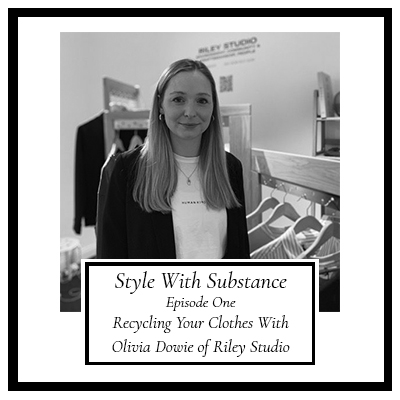Style With Substance – Episode One Recycling Your Clothing
In Episode One of Style With Substance we look at the truth behind clothing recycling. We are joined by Riley Studio CEO Olivia Dowie to talk about recycled fibres and circular fashion.
Episode One – Show Notes
Welcome to the first in our discussions about the Myths and greenwashing that surround Sustainable Fashion. We speak to Riley Studio CEO Olivia Dowie about recycling your clothes and using recycled fibres in their collections.
In this episode we are unpacking clothing recycling, how to do it, where it all goes and how to create new clothes from recycled waste. The recycling app ReGAIn, questioned 2,200 respondents and found that in spite of growing awareness concerning the importance of recycling, a large number of people are still throwing unwanted clothing items into the bin. Every year around 300,000 tones of used clothing ends up in landfill in the UK alone.
More of us are recycling more than ever before, thanks in part to initiatives powered by Love Not Landfill and High Street stores such as Zara and Marks and Spencer. However recycling your clothing should be a last resort. If it can’t be mended, repurposed, swapped, sold or donated to charity, only then should you consider recycling banks as an option. You may not be aware but what you recycle doesn’t necessarily go into making new clothes because of a lack of global infrastructure. Currently recycling is sorted by hand. Anything deemed wearable becomes part of a lucrative market in second hand clothes in Africa. Anything unwearable in down cycled to become sofa stuffing and insulation.
However there are some exciting brands out there that are using recycled fibres in their collections. Riley Studio is a gender neutral fashion brand with sustainability at it’s core. Our guest, Olivia Dowie is CEO of Riley Studio, working alongside the Founder Riley Uggla. The fashion industry has a huge waste problem. In the UK alone, 11 million items of clothing go to landfill. Riley Studio work with innovative recycled fabrics to create everyday staples. Fabrics that include ECONYL, QNOVA, Recover Yarn and Reverso regenerated cashmere. This one featured in Riley’s Winter collection as comfy sweaters and scarves. In everything they do Riley want to minimise their impact on the planet. Each piece is produced in small runs of 50. We discuss the difference between chemical and mechanical clothing recycling, microplastic shedding and the impact of using recycled fibers instead of using virgin fibers like cotton and wool. 97% of resources to make our clothes today come from virgin materials. If we flip that to instead using 97% recycled then what would happen to those people in the supply chain? Millions of people would be without jobs. Olivia is a staunch advocate of a balance between the use of the two.
How and when should you recycle your clothes and what happens to them once you drop them off in the collection bank? Olivia believes that this is problematic because while it’s great that brands are acknowledging that mass consumption is a problem, it should be the last resort after mending, donating, swapping, selling or keeping.
Not sure where to take your recycling? Check out the below handy apps and initiatives to help you make the right choice.
With thanks to our wonderful guest Olivia Dowie, CEO of Riley Studio. Thank you also to Lottie Hanson-Lowe at Hubbub and Hannah Carter at Love Not Landfill. And to Jenny Rose at Barley Communications.







